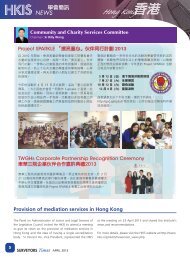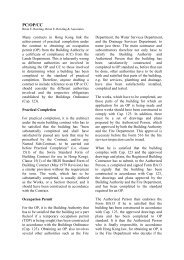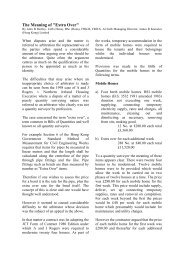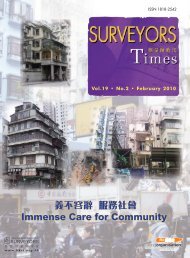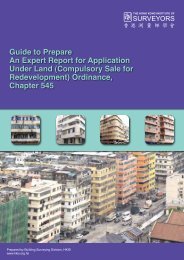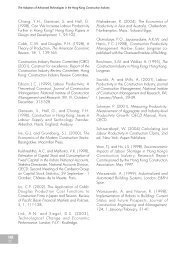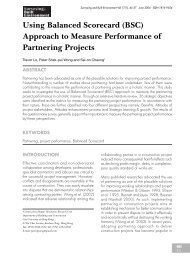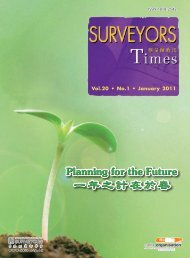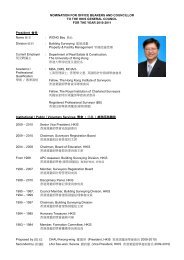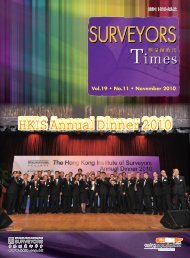Special issue to commemorate the 70th Anniversary of the Battle of ...
Special issue to commemorate the 70th Anniversary of the Battle of ...
Special issue to commemorate the 70th Anniversary of the Battle of ...
You also want an ePaper? Increase the reach of your titles
YUMPU automatically turns print PDFs into web optimized ePapers that Google loves.
Decoding <strong>the</strong> Enigma <strong>of</strong> <strong>the</strong> Fall <strong>of</strong> <strong>the</strong> Shing Mun Redoubt Using Line <strong>of</strong> Sight Analysis<br />
How did <strong>the</strong> Japanese troops attack <strong>the</strong> Redoubt after<br />
cutting <strong>the</strong> barbed wire?<br />
Ano<strong>the</strong>r major difference between <strong>the</strong> Cabinet findings<br />
and <strong>the</strong> Japanese source was that <strong>the</strong> former had been<br />
led <strong>to</strong> believe that <strong>the</strong> assault was carried out by <strong>the</strong><br />
Japanese climbing up Shing Mun Valley right up <strong>to</strong><br />
<strong>the</strong> positions on Smuggler’s Ridge above Point 341<br />
before descending <strong>to</strong> sweep <strong>the</strong> Redoubt. Most likely,<br />
this view was influenced by <strong>the</strong> skirmishes between <strong>the</strong><br />
Rajputs and <strong>the</strong> Japanese <strong>to</strong> <strong>the</strong> west <strong>of</strong> <strong>the</strong> Redoubt<br />
and <strong>the</strong> sequence <strong>of</strong> <strong>the</strong> fall <strong>of</strong> <strong>the</strong> OP and <strong>the</strong> pillboxes.<br />
Apparently, <strong>the</strong> Cabinet Office paid attention <strong>to</strong> only<br />
one attack leader o<strong>the</strong>r than Colonel Doi, and that<br />
would be Lt. Wakabayashi.<br />
The new Japanese source (Cheung Sha 1971) revealed<br />
that one <strong>of</strong> <strong>the</strong> immediate subordinates <strong>of</strong> Colonel Doi<br />
was Battalion Commander Major Nishiyama Haruka,<br />
who controlled two companies, <strong>the</strong> 9th and 10th under<br />
Lt. Kasugai and Lt. Wakabayashi, respectively. The<br />
wire cutting party and <strong>the</strong> cap<strong>to</strong>rs <strong>of</strong> PBs 401b and<br />
402 were part <strong>of</strong> <strong>the</strong> 9th Company, whereas <strong>the</strong> cap<strong>to</strong>rs<br />
<strong>of</strong> <strong>the</strong> OP were with <strong>the</strong> 10th Company. Note that<br />
Wakabayashi did not personally lead <strong>the</strong> party that<br />
captured <strong>the</strong> OP. Indeed, <strong>the</strong> Japanese inscription<br />
referring <strong>to</strong> <strong>the</strong> capture <strong>of</strong> <strong>the</strong> Redoubt by Wakabayashi<br />
was not found inside <strong>the</strong> OP, but near <strong>the</strong> entrance <strong>of</strong> a<br />
tunnel (Shafttsbury Avenue) physically unconnected <strong>to</strong><br />
<strong>the</strong> OP. Outside this entrance was a path junction that<br />
branched out (a) upwards <strong>to</strong> <strong>the</strong> OP and (b) eastwards<br />
horizontally <strong>to</strong>wards <strong>the</strong> Strand Palace Hotel entrance.<br />
We have reasons <strong>to</strong> believe that <strong>the</strong> following events<br />
are what actually happened. The Japanese actually<br />
ascended <strong>the</strong> Redoubt proper from near <strong>the</strong>ir assembly<br />
point near <strong>the</strong> Redoubt end <strong>of</strong> <strong>the</strong> Jubilee Dam,<br />
seeking <strong>to</strong> attack PBs 401b and 402. Subsequent<br />
reinforcements <strong>of</strong> <strong>the</strong> 10th Company also came up<br />
along <strong>the</strong> same route and <strong>the</strong>n branched out southwards<br />
<strong>to</strong> invest <strong>the</strong> OP and Strand Palace Hotel through <strong>the</strong><br />
Charing Cross or T3 (see Figure 2) tunnel entrance.<br />
After shooting at <strong>the</strong> Japanese for some time, <strong>the</strong> 19<br />
Royal Scots who were not trapped inside <strong>the</strong> OP and<br />
PB 401b, losing phone contact with <strong>the</strong>ir commander<br />
in <strong>the</strong> OP or <strong>the</strong>ir comrades inside <strong>the</strong> pillbox, decided<br />
<strong>to</strong> move <strong>to</strong> a position on higher ground <strong>to</strong> conduct a<br />
better defence lest <strong>the</strong> Redoubt would be fully encircled<br />
by <strong>the</strong> enemy. Thus, <strong>the</strong>y left five wounded behind<br />
and moved southwards through <strong>the</strong> underground tunnel<br />
system with which <strong>the</strong>y were familiar, came out in<strong>to</strong><br />
<strong>the</strong> open, and ascended <strong>to</strong> higher ground on Smuggler’s<br />
Ridge above <strong>the</strong> OP and <strong>the</strong> rest <strong>of</strong> <strong>the</strong> Redoubt. As<br />
<strong>the</strong>y moved very quickly through <strong>the</strong> tunnels, <strong>the</strong>y did<br />
not engage any enemy assault team, <strong>the</strong>n largely above<br />
ground, before making contact with <strong>the</strong> Rajputs. It<br />
was very likely that when <strong>the</strong>y reached <strong>the</strong> vicinity<br />
<strong>of</strong> <strong>the</strong> OP, it had already fallen and <strong>the</strong> Japanese <strong>the</strong>re<br />
had turned north in<strong>to</strong> <strong>the</strong> tunnel system in search <strong>of</strong> <strong>the</strong><br />
remaining defenders and <strong>to</strong> capture <strong>the</strong> last pillbox.<br />
The Japanese attackers numbered only about 40. Had<br />
<strong>the</strong>y committed additional men <strong>to</strong> assault <strong>the</strong> higher<br />
ground above <strong>the</strong> OP at <strong>the</strong> western end <strong>of</strong> Smugglers’<br />
Ridge, <strong>the</strong>y would have been in position <strong>to</strong> intercept<br />
<strong>the</strong> withdrawing Royal Scots. Judging from <strong>the</strong> fine<br />
fighting record <strong>of</strong> <strong>the</strong> Royal Scots during <strong>the</strong> <strong>Battle</strong> <strong>of</strong><br />
Hong Kong, we do not believe that <strong>the</strong>y retreated from<br />
<strong>the</strong> enemy due <strong>to</strong> cowardice.<br />
Facts about <strong>the</strong> layout <strong>of</strong> <strong>the</strong> Redoubt: How many OP<br />
exits were <strong>the</strong>re?<br />
In <strong>the</strong> Cabinet Report (Latham 1958), Banham (2003),<br />
and Lindsay (2005) were convinced that <strong>the</strong> defenders<br />
<strong>of</strong> <strong>the</strong> OP were “trapped” after <strong>the</strong> runner went out<br />
with <strong>the</strong> key <strong>to</strong> <strong>the</strong> gate. However, <strong>to</strong> reiterate, even a<br />
casual site visit would have revealed that <strong>the</strong> OP had<br />
more than one exit. There are 3 hatches and an exit<br />
that proceeds down Strand Palace Hotel via a tunnel.<br />
We could reconcile this apparent discrepancy with a<br />
careful reading <strong>of</strong> <strong>the</strong> Japanese source, which revealed<br />
how <strong>the</strong> party led by Mochizuki captured those inside<br />
<strong>the</strong> OP – <strong>the</strong>y accidently discovered an opening that led<br />
up it. Probably while o<strong>the</strong>r Japanese soldiers attempted<br />
<strong>to</strong> break in<strong>to</strong> <strong>the</strong> OP from above, Mochizuki’s party<br />
sought <strong>to</strong> break in from below, likely from trench T3,<br />
as our detailed site survey discovered and reported<br />
in <strong>the</strong> next section, in<strong>to</strong> Charing Cross or <strong>the</strong> kitchen<br />
(Strand Palace Hotel) tunnel. This factual question<br />
about <strong>the</strong> physical layout <strong>of</strong> <strong>the</strong> OP brought us <strong>to</strong> a key<br />
factual error 10 stated in <strong>the</strong> Cabinet Report.<br />
Facts about <strong>the</strong> layout <strong>of</strong> <strong>the</strong> Redoubt: Was <strong>the</strong> OP<br />
connected <strong>to</strong> <strong>the</strong> Pillboxes by tunnels?<br />
The Royal Scots’ battle diary produced a sketch map<br />
showing that <strong>the</strong> OP was cut <strong>of</strong>f from <strong>the</strong> main system<br />
<strong>of</strong> tunnels <strong>to</strong> <strong>the</strong> pillboxes. Maltby, <strong>the</strong> ranking British<br />
military commander in Hong Kong during <strong>the</strong> battle,<br />
admitted in a questionnaire <strong>to</strong> <strong>the</strong> Cabinet Office that he<br />
had never visited <strong>the</strong> Redoubt himself. In <strong>the</strong> absence<br />
<strong>of</strong> any independent field investigation, a large scale<br />
layout <strong>of</strong> <strong>the</strong> Redoubt, or oral evidence, <strong>the</strong> Cabinet<br />
inquiry found that key parts in <strong>the</strong> entire Redoubt were<br />
interconnected by tunnels. It was not certain how it<br />
arrived at this discovery, although whe<strong>the</strong>r <strong>the</strong> Redoubt<br />
consisted <strong>of</strong> one or more system <strong>of</strong> tunnels mattered<br />
little <strong>to</strong> us.<br />
Modes <strong>of</strong> Fighting<br />
How was <strong>the</strong> battle actually fought? The presence <strong>of</strong><br />
<strong>the</strong> tunnels inside <strong>the</strong> Redoubt easily conjured up images<br />
<strong>of</strong> dramatic hot chases and fighting in subterranean<br />
corridors. (See, for instance, Banham’s (2003:<br />
38), Lindsay’s (2005: 75, quoting Doi), Thrower’s<br />
(1985: 90) accounts.) The following postwar (1946)<br />
description <strong>of</strong> <strong>the</strong> action at <strong>the</strong> Redoubt in <strong>the</strong> memoir<br />
<strong>of</strong> Lt. General Kitajima suggests that <strong>the</strong> actual fighting<br />
was much quieter, though no less exciting.<br />
On <strong>the</strong> evening <strong>of</strong> 9th December, <strong>the</strong> vanguard<br />
led by Wakabayashi arrived at <strong>the</strong> hill overseeing<br />
Shing Mun Reservoir and saw <strong>the</strong> enemy’s<br />
defences as inadequate.<br />
The master plan was <strong>to</strong> attack after an initial<br />
10<br />
This is curious, as <strong>the</strong> sketch map (“Map 3”) adopted by <strong>the</strong> Cabinet Office also shows a gap between <strong>the</strong> two tunnel systems. The map is<br />
conceptually and largely correct, but inaccurate as <strong>to</strong> scale and proportion.<br />
SBE<br />
32



